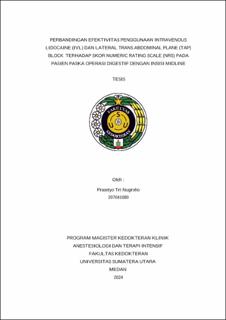| dc.description.abstract | Introduction: Most abdominal wall surgical techniques involve various types of incisions, including midline. Analgesic methods need to be safe, efficient, and not interfere with mobility. Local anesthesia methods, including intravenous lidocaine (IVL) or lateral transabdominal plane blockade (lateral TAP Block), can help reduce the need for opioids. This study aims to compare IVL and lateral TAP Block in terms of the numeric rating scale (NRS) score and the amount of rescue anesthesia fentanyl used in patients undergoing digestive surgery with a midline incision.
Method: This study is a single-blind randomized controlled clinical trial on patients undergoing elective and emergency digestive surgery with midline incision at the Central Surgical Installation of RS Adam Malik, Kamar Bedah Emergency (KBE) of RS Adam Malik, surgical room of Haji General Hospital, Medan, and surgical room of Dr. Pringadi Regional General Hospital. The samples included in the study were selected based on inclusion criteria, exclusion criteria, and dropout criteria, with a sample size of 29 patients per group. Data were analyzed using an unpaired T-Test for normally distributed data and the Mann-Whitney test for non-normally distributed data, with a p-value <0.05 considered statistically significant.
Results: Based on the research findings, there were 24 individuals in each group, IVL and lateral TAP Block, with an analysis of the difference in mean NRS values T1, T2, T3, T4 respectively showing p-values <0.05, namely 0.001, 0.009, 0.013, and 0.025, with better values in the lateral TAP Block. Meanwhile, the comparison of the need for rescue anesthesia with fentanyl showed differences in the variables T1 and T2 with p-values <0.05, with better values in the lateral TAP Block.
Conclusion: The use of the lateral TAP Block is more effective in reducing NRS scores and the need for rescue analgesia compared to the use of IVL. | en_US |


